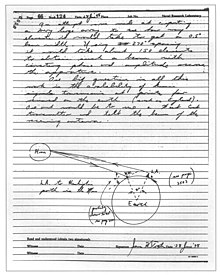Communication Moon Relay
This article includes a improve this article by introducing more precise citations. (June 2008) ) |
Background
Communication Moon Relay grew out of many ideas and concepts in radio espionage. Some impetus for the project was provided by post-
Prior to the Moon Relay project, long distance wireless communication around the curve of the Earth was conducted by skywave ("skip") transmission, in which radio waves are refracted by the Earth's ionosphere, which was sometimes disrupted by solar flares and geomagnetic storms. Before artificial satellites, the Moon provided the only reliable celestial object from which to reflect radio waves to communicate between points on opposite sides of the Earth.

The developments in Moon circuit communications eventually came to the attention of
In September 1950, a new parabolic antenna for the PAMOR project was completed at Stump Neck, Maryland. The first tests of this antenna were impressive; the returning signal was of much higher fidelity than expected. This presented the possibility of using a Moon circuit as a communications circuit. Unfortunately for PAMOR, collecting Soviet radar signals would require a larger antenna. Efforts began to have such an antenna constructed at Sugar Grove, West Virginia.
Development
With the PAMOR project requiring a larger antenna, the Stump Neck antenna was pushed into service for testing whether communication via the Moon was possible. This marked the emergence of the Moon Relay as a separate project. Test transmissions between Stump Neck and
The Navy received the new system favorably. A Navy contract for the project soon followed the successful tests, and, among other things, it was recommended that American submarines use Moon-reflection paths for communications to shore.
Expansion
The Moon Relay project was soon transferred to the Communications Section of the Radar Division of the Naval Research Laboratory. Under this department, the system was upgraded to use the ultra high frequency (UHF) band. The experimental system was transformed into a fully operational lunar relay system linking Hawaii with Washington, DC, which became functional in 1959. The new system was officially inaugurated in January 1960, when Chief of Naval Operations Admiral Arleigh Burke sent a message to Commander, Pacific Fleet Felix Stump using the system.
The finished system used two sets of transmitters at
Results
The Moon Relay system became obsolete in the later 1960s as the Navy implemented its artificial satellite communication system. However, the information gleaned from the project in fact made the later artificial system possible. Additionally, the equipment used in the Communications Moon Relay project was of much use to U.S. Navy astronomers, as they used it to examine the Moon when the Moon was not in a position conducive to radio transmission. Although relatively short-lived, the Moon Relay served as a bridge to modern American military satellite systems.

